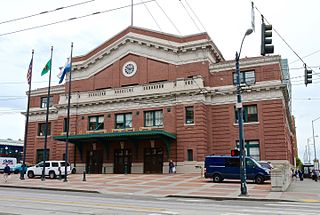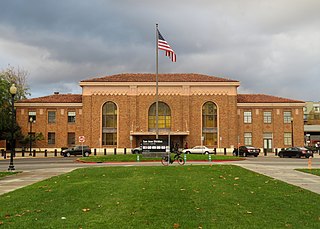Related Research Articles

North Charleston is a city in Berkeley, Charleston, and Dorchester counties within the U.S. state of South Carolina. As of the 2020 census, North Charleston had a population of 114,852, making it the 3rd most populous city in the state, and the 248th most populous city in the United States. North Charleston is a principal city within the Charleston-North Charleston, SC Metropolitan Statistical Area, which had a population of 799,636 in 2020.

Miami-Dade Transit (MDT) is the primary public transit authority of Miami, Florida and the greater Miami-Dade County area. It is the largest transit system in Florida and the 15th-largest transit system in the United States. As of 2022, the system has 60,734,900 rides per year, or about 251,100 per weekday in the second quarter of 2023. MDT operates the Metrobus with their paratransit STS systems run by LSF. MDT also operates two rail transit systems: Metrorail and Metromover.

Sound Transit (ST), officially the Central Puget Sound Regional Transit Authority, is a public transit agency serving the Seattle metropolitan area in the U.S. state of Washington. It operates the Link light rail system in Seattle and Tacoma, regional Sounder commuter rail, and Sound Transit Express bus service. The agency also coordinates the regional ORCA fare card system, which is also used by local transit operators. In 2019, Sound Transit services carried a total of 48 million passengers and averaged over 161,000 riders on weekdays.

Spokane Transit Authority, more commonly Spokane Transit or STA, is the public transport authority of central Spokane County, Washington, United States, serving Spokane, Washington, and its surrounding urban areas. In 2022, the system had a ridership of 6,995,300, or about 30,200 per weekday as of the second quarter of 2023.

The Tel Aviv Light Rail, also known as Dankal is a mass transit system for the Tel Aviv metropolitan area in central Israel. The system will include different modes of mass transit, including rapid transit (metro), light rail transit (LRT), and bus rapid transit (BRT). Overseen by the government agency NTA, the project will complement the intercity and suburban rail network operated by Israel Railways.

The Charleston Area Regional Transportation Authority (CARTA) provides area residents and visitors public transportation within parts of Charleston and Dorchester counties in the Lowcountry region of South Carolina, including the cities of Charleston, North Charleston and the surrounding communities of Mount Pleasant, Summerville, James Island, Sullivan's Island, and the Isle of Palms. CARTA presently contracts with Transdev for staffing and managing the bus drivers in addition to maintaining and scheduling the buses. In 2022, the system had a ridership of 2,191,500, or about 7,100 per weekday as of the second quarter of 2023.

San Jose Diridon station is the central passenger rail depot for San Jose, California. It also serves as a major intermodal transit center for Santa Clara County and Silicon Valley. The station is named after former Santa Clara County Supervisor Rod Diridon.

Area codes 843 and 854 are telephone area codes in the North American Numbering Plan (NANP) for a portion of the U.S. state of South Carolina that comprises roughly the eastern third and the southern tip. The numbering plan area (NPA) includes the Grand Strand, the Lowcountry, the Pee Dee, and the Sandhills. Major cities in the region are Myrtle Beach, Charleston, Beaufort, Hilton Head Island and Florence. Area code 843 was created in 1998 when area code 803 was split, while 854 was added in 2015 to form an all-services overlay.
The Metro Purple Line, formerly known as the Rush Line Corridor, is a proposed bus rapid transit service that would run from Union Depot in downtown Saint Paul to the northeastern suburbs of Saint Paul. Along the corridor's 21 proposed stations there are 106,000 jobs within a 10-minute walk. The project is currently in an environmental analysis phase with further development, engineering, and construction expected to take at least six more years. Service would run 7-days a week with 10-minute headways in peak periods and 15-minute service at most other times. The corridor was named the Rush Line because it was originally planned to end in Rush City, Minnesota. After using the color purple since 2017, the route was officially named the Purple Line and became part of the Metro network on July 14, 2021.

The MRT 3, MRT Line 3 or MRT Circle Line is a proposed thirteenth rail transit line, the third Mass Rapid Transit line and the fourth fully automated and driverless rail system in the Klang Valley, Malaysia. Once completed, this line would form the loop line of the Klang Valley Integrated Transit System. The director of this project is currently Tuan Haji Mohd Yusof Kasiron. The circle line will be numbered 13.

Bus rapid transit in New Jersey comprises limited-stop bus service, exclusive bus lanes (XBL) and bus bypass shoulders (BBS). Under the banner Next Generation Bus New Jersey Transit (NJT), the New Jersey Department of Transportation (NJDOT), and the metropolitan planning organizations of New Jersey (MPO) which recommend and authorize transportation projects are undertaking the creation of several additional bus rapid transit systems (BRT) in the state.

Metro is a transit network in Minnesota serving the cities of Minneapolis and Saint Paul. It also provides service to some suburban areas. As of 2022 the system consists of two light rail lines and five bus rapid transit (BRT) lines all of which are operated by the local public transit company: Metro Transit. The five lines connect Downtown Minneapolis and St Paul with the Bloomington, Minneapolis-St Paul International Airport, Roseville, Richfield, Burnsville and Brooklyn Center.

The Glassboro–Camden Line (GCL) is a planned 18-mile (29 km) diesel multiple unit (DMU) light rail system to be located in South Jersey.
The Metro Rail Transit Line 4 (MRT-4) is an upcoming rapid transit line serving the Greater Manila Area of the Philippines. The 12.7 km (7.9 mi), 10-station elevated railway will connect Ortigas Center in Metro Manila and the suburban municipality of Taytay in the neighboring province of Rizal. It will traverse along Ortigas Avenue and Manila East Road, starting at the former's junction with EDSA in Quezon City to the west until it terminates near the New Taytay Public Market to the east.
The BMA Bang Na–Suvarnabhumi line is a proposed light rail line in Bangkok that would run from Bang Na junction to Suvarnabhumi Airport. The line was first proposed in 1994, but it was not included in the 2005 OTP Mass Rapid Transit Master Plan. Initially, it was planned for the line to potentially be a BTS Sukhumvit Line branch line with turnouts constructed near Bang Na junction. In December 2015, the BMA said it would advance construction and would propose it to cabinet in the near future. In April 2016, deputy governor Amorn Kitchawengkul said the project would take 3–6 years and cost THB 20 billion.

The Swift Green Line is a bus rapid transit route in Snohomish County, Washington, United States, part of the Swift network operated by Community Transit. It was opened in 2019 and travels 12.5 miles (20.1 km) along Airport Way and State Route 527, connecting 32 stations in the cities of Everett, Mill Creek, and Bothell. Its termini are at Seaway Transit Center, adjacent to the Boeing factory, and Canyon Park Park and Ride on Interstate 405; the Green Line also intersects the Blue Line in Everett and also serves Paine Field.
The Twenty-eight by '28 initiative is an effort set forth by former Mayor Eric Garcetti that the City of Los Angeles complete 28 transportation infrastructure projects before the start of the 2028 Summer Olympics on July 14, 2028 and the 2028 Summer Paralympics the following month.
The Lowcountry Lowline is a planned linear park in Charleston, South Carolina to be located on 1.7 miles of old railroad roadbed. It will run from Mt. Pleasant Street to Courtland Street. The park is being planned by the Friends of the Lowcountry Lowline. Since 2021, more than $10.25 million in city and federal funding has gone to the planning of the park. Currently, the park is in the community-engagement and strategy phase.
References
- 1 2 Baldwin, Skyler (2 April 2018). "Charleston's major mass-transit project could change how SC commutes". Charleston City Paper. Retrieved 2020-07-29.
- 1 2 Dennis Jr., Slade, and Wise (2020-02-02). "Overlooked for years, North Charleston's south end awaits transformation". Post and Courier. Retrieved 2020-07-29.
{{cite web}}: CS1 maint: multiple names: authors list (link) - ↑ Baldwin, Skyler (2023-03-24). "Bus rapid transit project enters final design stage". Charleston City Paper. Retrieved 2023-07-28.
- 1 2 3 Peterson, Jenny (June 14, 2023). "Details emerge on state's first $625M mass transit system in Charleston > Charleston Business Journal". Charleston Business. Retrieved 2023-09-18.
- 1 2 3 Benre, Robert (19 December 2018). "Charleston region to study how bus rapid transit could reshape neighborhoods". Post and Courier. Retrieved 2020-07-29.
- ↑ Darlington, Abigail (2018-12-23). "Here's what the Charleston region has to do to make robust transit a reality". Post and Courier. Retrieved 2020-07-29.
- ↑ Baldwin, Skyler (2022-01-30). "Charleston-area COG gets $860K grant for rapid transit". Charleston City Paper. Retrieved 2022-01-31.
- ↑ Kennedy, Destiny (2023-07-27). "Lowcountry Rapid Transit workshops give public a chance to weigh in on project". Live5News. Retrieved 2023-07-28.